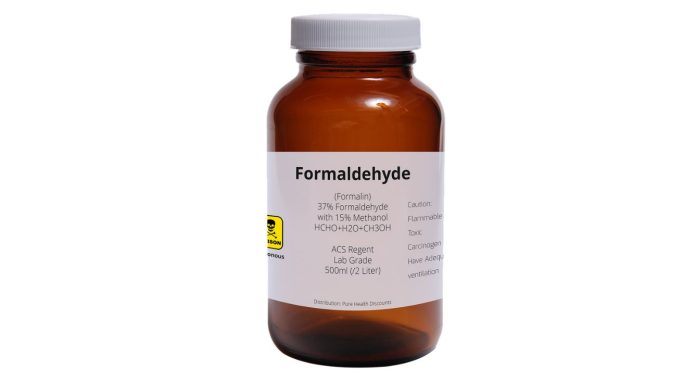By Tom Gantert
(The Center Square) – In 2005 when Hurricane Katrina struck the United States, many victims were housed in trailers that were filled with formaldehyde at levels high enough to cause coughing, nausea and skin rashes.
In the nearly 20 years since then, there has been an ongoing debate on how dangerous formaldehyde can be and at what levels exposure can lead to cancer.
Formaldehyde is best known as an embalming fluid used by funeral directors to preserve dead bodies. However, it has far more uses than that. Formaldehyde is used in electric vehicles, vaccines and medical devices. It is also produced by the human body as part of the metabolism.
The EPA has branded formaldehyde as a “probable human carcinogen under conditions of unusually high or prolonged exposure” since 1987. The U.S. National Toxicology Program, which is a collection of several different federal agencies, lists formaldehyde as “known to be a human carcinogen.”
In 2022, the EPA released a draft of a report that stated “inhaled formaldehyde causes LHP cancers, including myeloid leukemia.”
Truth in Science released a report in April 2024 that found no evidence of a connection between inhaled formaldehyde and cancer. It’s part of an ongoing dispute over the 2022 EPA determination that ended up in court.
“Any assessment of formaldehyde must begin with best available science and the undeniable fact that formaldehyde is an ever-present part of the natural world that, through decades of responsible innovation and regulation, has become essential to goods including sustainable wood products, electric vehicles, and lifesaving vaccines and medical devices,” the American Chemistry Council said in an August 2023 statement.
The Center for Truth in Science funded a review of the EPA’s findings on formaldeyde. Scientists from ToxStrategies concluded there was “no credible explanation for the agency’s 2022 claim that inhaled formaldehyde causes LHP cancers, including myeloid leukemia.”
“Claims that are not rooted in strong science can be dangerous,” Jacob Traverse, CEO of the Center for Truth in Science, said in an April 2024 statement. “They impact many industries and Americans that rely on those industries. As the EPA finalizes its report, we encourage it to consider elevating its methodology to the standards of rigor recommended by the National Academies.“
The American Chemistry Council filed a lawsuit in July 2023 in the U.S. District Court for the District of Columbia against the EPA and the National Academies of Sciences, Engineering, and Medicine (NASEM). The complaint wanted the NASEM to “follow basic principles of independence, transparency, and sound science in accordance with its legal obligations as part of its reviewing EPA’s draft assessment of formaldehyde.”
“Formaldehyde is a critical building block for essential applications including agriculture, food safety, medical devices, semiconductors, automobiles/electric vehicles, and affordable housing,” the American Chemistry Council stated. “Formaldehyde technologies have broad roles in the economy, supporting 987,000 jobs and $552.7 billion in sales in 2022 in the United States.”
A judge dismissed the American Chemistry Council’s lawsuit in March 2023 but not based on the merits of its arguments, ruling it “lacked standing.”
The EPA noted the lawsuit’s dismissal in an email to The Center Square.
Here’s the EPA’s statement:
“Formaldehyde is a hazardous air pollutant (HAP) common in both indoor and outdoor air, leading to widespread human exposure. Exposures can occur in homes and schools from building materials and furnishings such as plywood and adhesives in upholstery, and indoor combustion sources such as cigarettes; in industry or businesses creating or using formaldehyde-based products; and outdoor sources such as combustion processes (e.g., auto emissions), emissions from manufacturing processes, and from agricultural uses. Formaldehyde levels outdoors are lower.”
The statement continued:
“Conclusions presented in EPA’s draft assessment are based on the state-of-the-science review of the publicly available literature. EPA concluded in its draft assessment that formaldehyde is ‘carcinogenic to humans.‘ Formaldehyde inhalation can cause cancer in the upper respiratory tract (e.g., nasal cancers) and evidence demonstrates inhalation of formaldehyde causes myeloid leukemia in humans and that evidence suggests, but is not sufficient to infer, that formaldehyde may cause multiple myeloma and Hodgkin lymphoma in humans. Further, the draft assessment finds that exposure can cause noncancer respiratory effects (e.g., sensory irritation, decreased pulmonary function, increased prevalence of asthma symptoms or difficulty controlling asthma, and increased allergic responses in humans).”
The EPA also said the National Academies of Sciences Engineering and Medicine (NASEM) peer-reviewed the EPA’s draft conclusions on specific lymphohematopoietic (LHP) cancers and “supported EPA’s conclusions.”


























